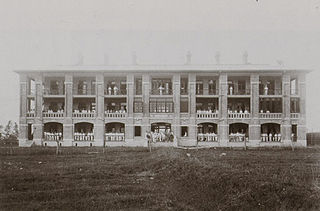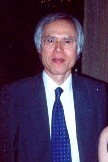
Yue is a branch of the Sinitic languages primarily spoken in Southern China, particularly in the provinces of Guangdong and Guangxi (Liangguang).

Lingnan University in Guangzhou (Canton), China, was a private university established by a group of American missionaries in 1888. At its founding it was named Canton Christian College (格致書院).

Lingnan University (LN/LU), formerly called Lingnan College, is a public liberal arts university in Hong Kong. It aims to provide students with an education in the liberal arts tradition and has joined the Global Liberal Arts Alliance since 2012. Lingnan University became the first university in Hong Kong to accomplish the goal of providing rich hostel experience for all undergraduates and currently, 80% Lingnan students are able to go on exchange for a term during their undergraduate study.
Cantonese culture, or Lingnan culture, refers to the regional Chinese culture of the region of Lingnan: twin provinces of Guangdong and Guangxi, the names of which mean "eastern expanse" and "western expanse", respectively.

Wong Kwok Pun is a Hong Kong scholar, poet and translator. He is most famous for rendering Dante's La Divina Commedia into Chinese while preserving the terza rima rhyming scheme, an approach no Chinese translator had ever tried to take.
Wong Shik-Ling (1908–1959) was a prominent scholar in Cantonese research. He is famous for his authoritative book, A Chinese Syllabary Pronounced According to the Dialect of Canton (《粵音韻彙》), which is influential in Cantonese research.

Tong sui, also known as tim tong, is a collective term for any sweet soup or custard served as a dessert typically at the end of a meal in Chinese cuisine. Tong sui originated in the Lingnan region of China, including Guangdong, Guangxi, Hainan, Hong Kong, Macau, and some parts of other provinces in China. Therefore, in the narrow sense, the term tong sui is used to refer to soupy desserts from Lingnan, while occasionally it is also used in the broad sense, referring to any soupy dessert in Chinese-speaking regions.

The Cantonese people or Yue people, are a Yue-speaking ethnic group or Han Chinese subgroup originating from or residing in the provinces of Guangdong and Guangxi, in Southern Mainland China. More accurately, "Cantonese" refers only to people with roots from Guangzhou and its satellite cities and towns, rather than generally referring to the people of the Liangguang region.

The Lingnan University Library, named after the late benefactor Fong Sum Wood in 1998, is located in the Main Building of Lingnan University, Hong Kong and occupies four floors.
James Tak Wu, GBS, was a Hong Kong businessman who co-founded Maxim's Catering and co-founded a chain of restaurants, nightclubs, fast-food outlets, cake and coffee shops, institutional catering units and theaters throughout Hong Kong. As of 2015, Wu remained Honorary Chairman of Maxim's Group under Jardine Matheson's ownership.

Guangzhou–Shenzhen–Hong Kong Express Rail Link (XRL), also known as “Guangshengang XRL”, is a high-speed railway line that connects Beijing and Hong Kong (Kowloon) via Guangzhou and Shenzhen.
Lingnan (岭南) is a geographic region in southern China.

Jian Youwen was a Chinese historian, public official, and sometime Methodist pastor, known in particular for his writings on the Taiping Heavenly Kingdom. He taught at Yenching University, the University of Hong Kong, and Yale University.
Chao Shao-an or Zhao Shao'ang was a Chinese artist of the Lingnan School of painting.
Desmond Lee Yu-tai is a retired Hong Kong politician, a member of Eastern District Council for most of a 30-year period and a former member of the Legislative Council of Hong Kong.

Liao Deshan (Chinese: 廖德山; was a Chinese educator of the early 20th century. He was a close friend and advisor of Sun Yat-sen and revolutionaries held meetings at his home. Liao's family played an instrumental role in the modernisation of education in China and in 1890 he also founded Pui Ching Middle Schools 培正中学.
Pang Chai-sip was a renowned Hong Kong artist of the Lingnan school of Chinese painting. Born in Guangdong, Pang started his life in art as a student at the Art Institute of Guangzhou (廣州市立美術學院), by which he learnt his painting skills and philosophy with virtuosos in the field like Li Yanshan, Li Jinfa, Chao Shao-an, Huang Junbi and Li Xiongcai.

Lingnan architecture, or Cantonese architecture, refers to the characteristic architectural style(s) of the Lingnan region – the Southern Chinese provinces of Guangdong and Guangxi. Usually, it is referring to the architecture associated with the Cantonese people, with other peoples in the area having their own styles. This style began with the architecture of the ancient non-Han Nanyue people and absorbed certain architectural elements from the Tang Empire and Song Empire as the region sinicized in the later half of the first millennium AD.
Guangdong-Hong Kong-Macao University Alliance (GHMUA) is an alliance of 37 prestigious universities located in mainland China, Hong Kong and Macau. It was established on 15 November 2016.










